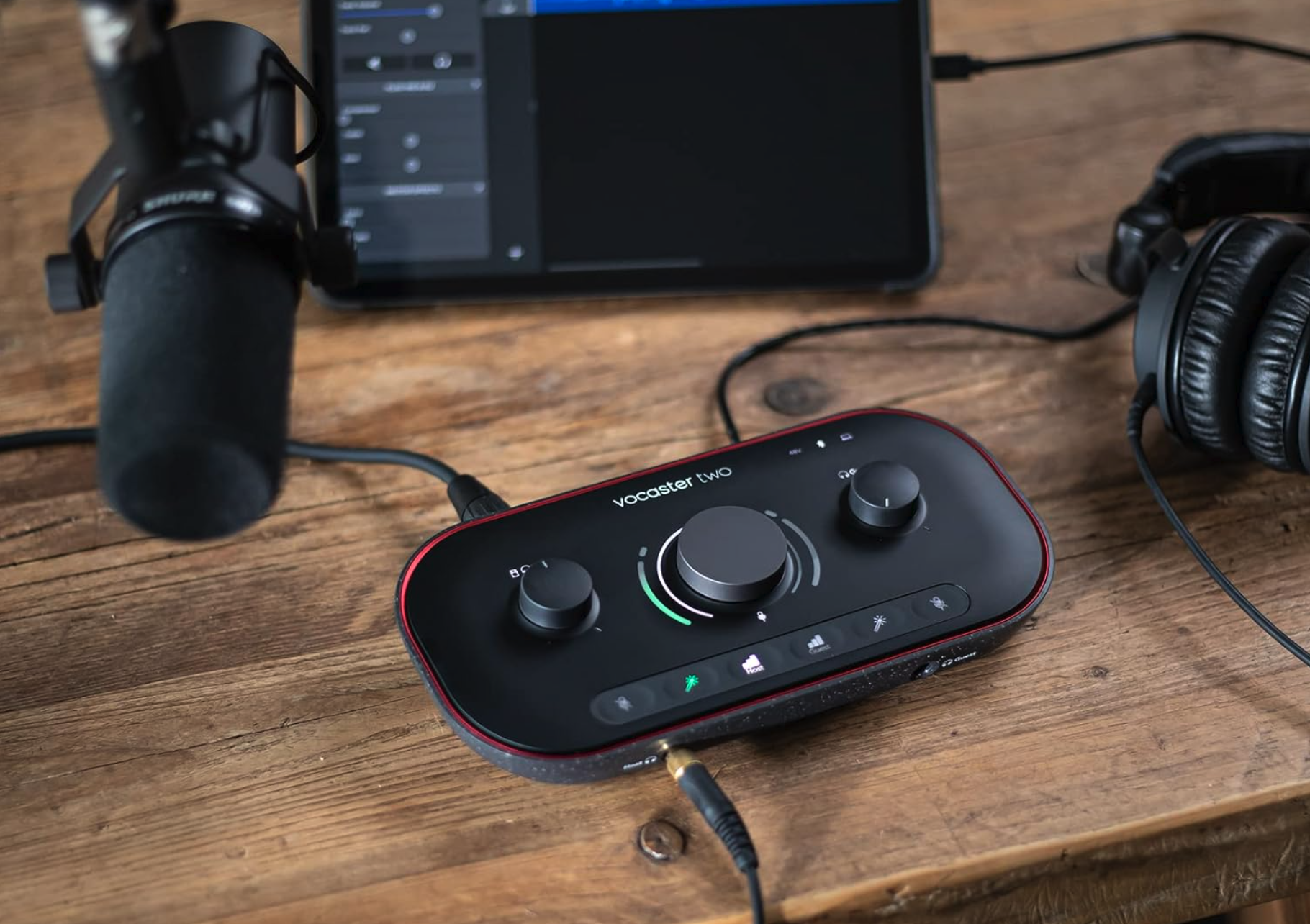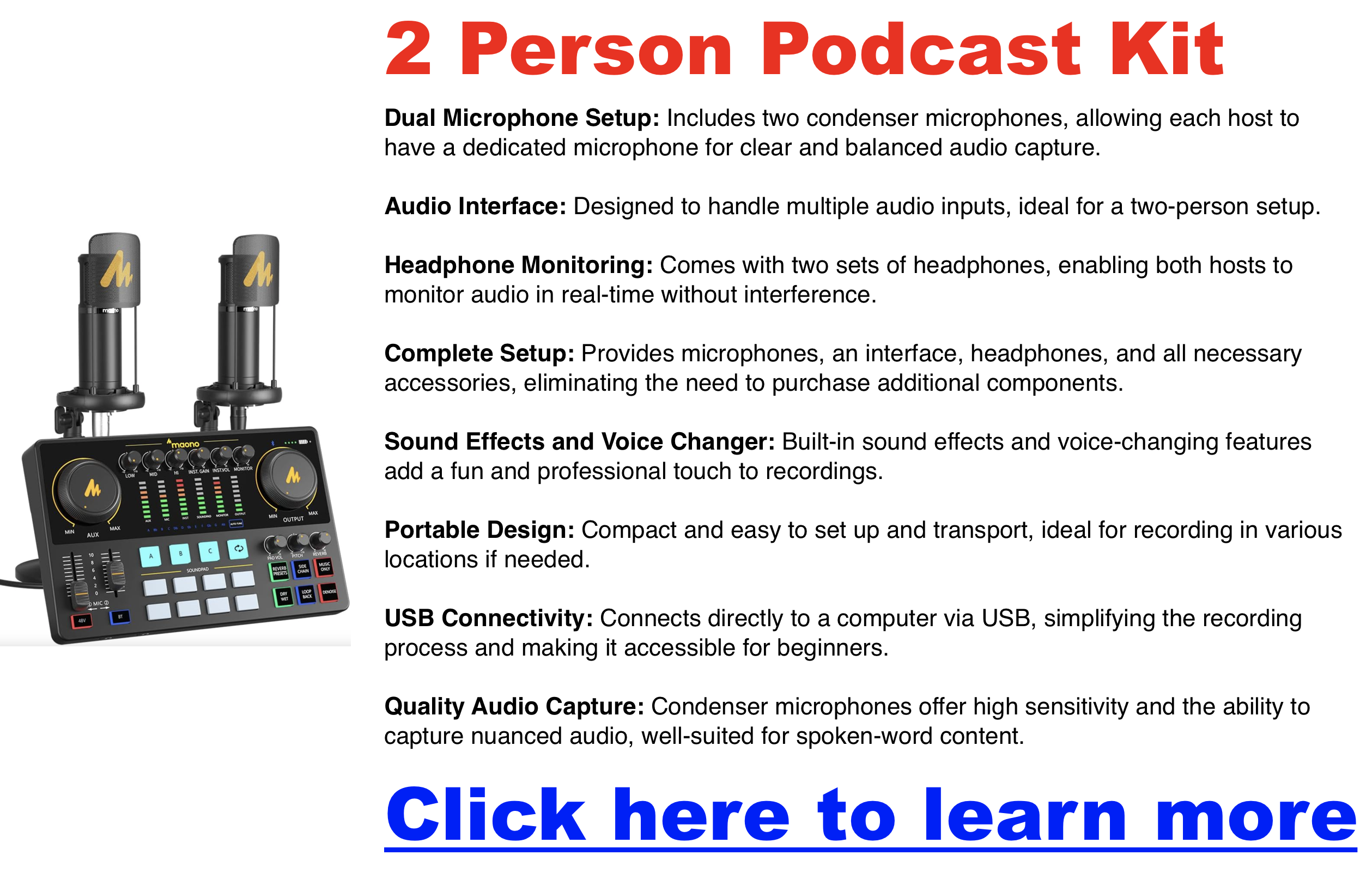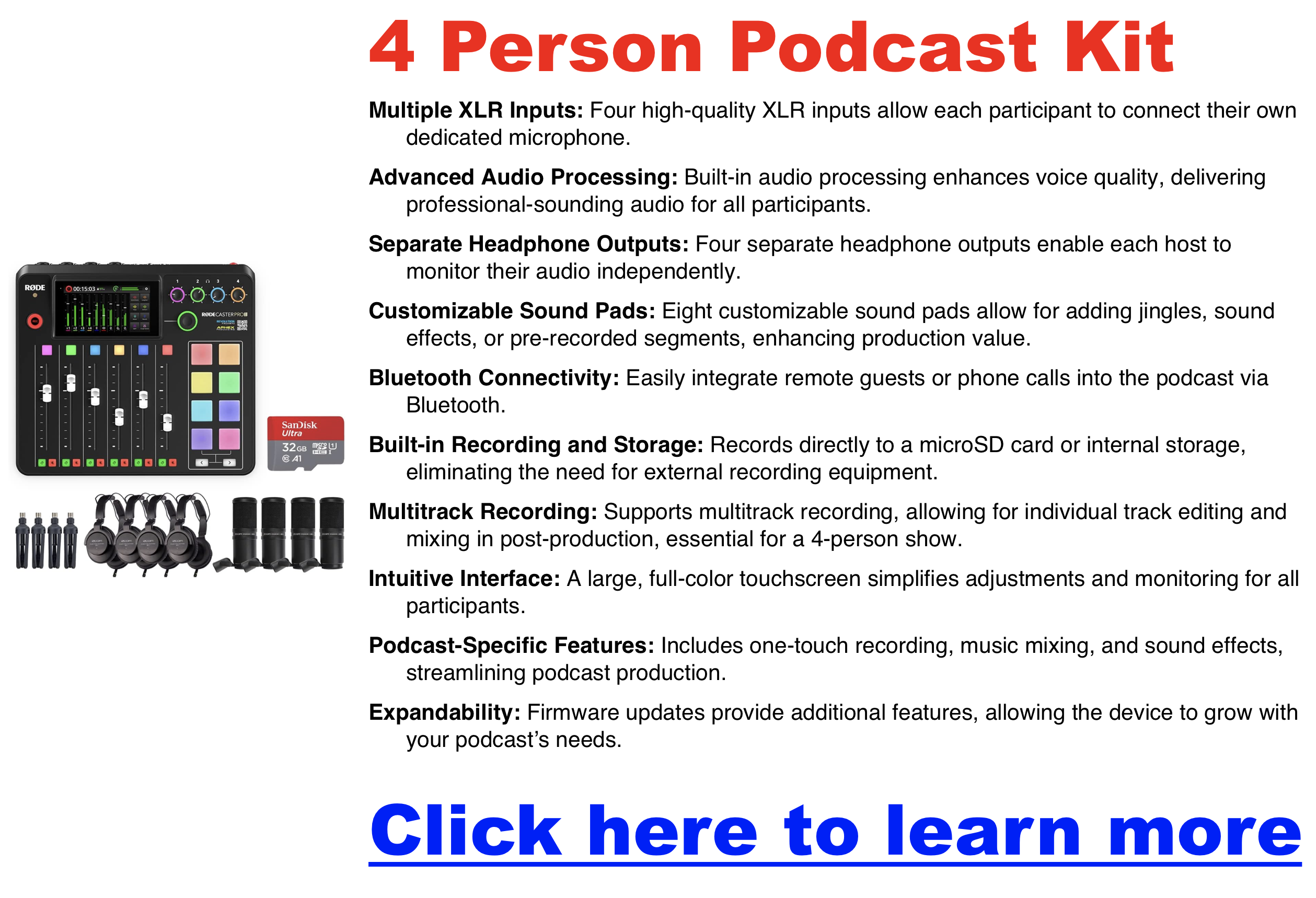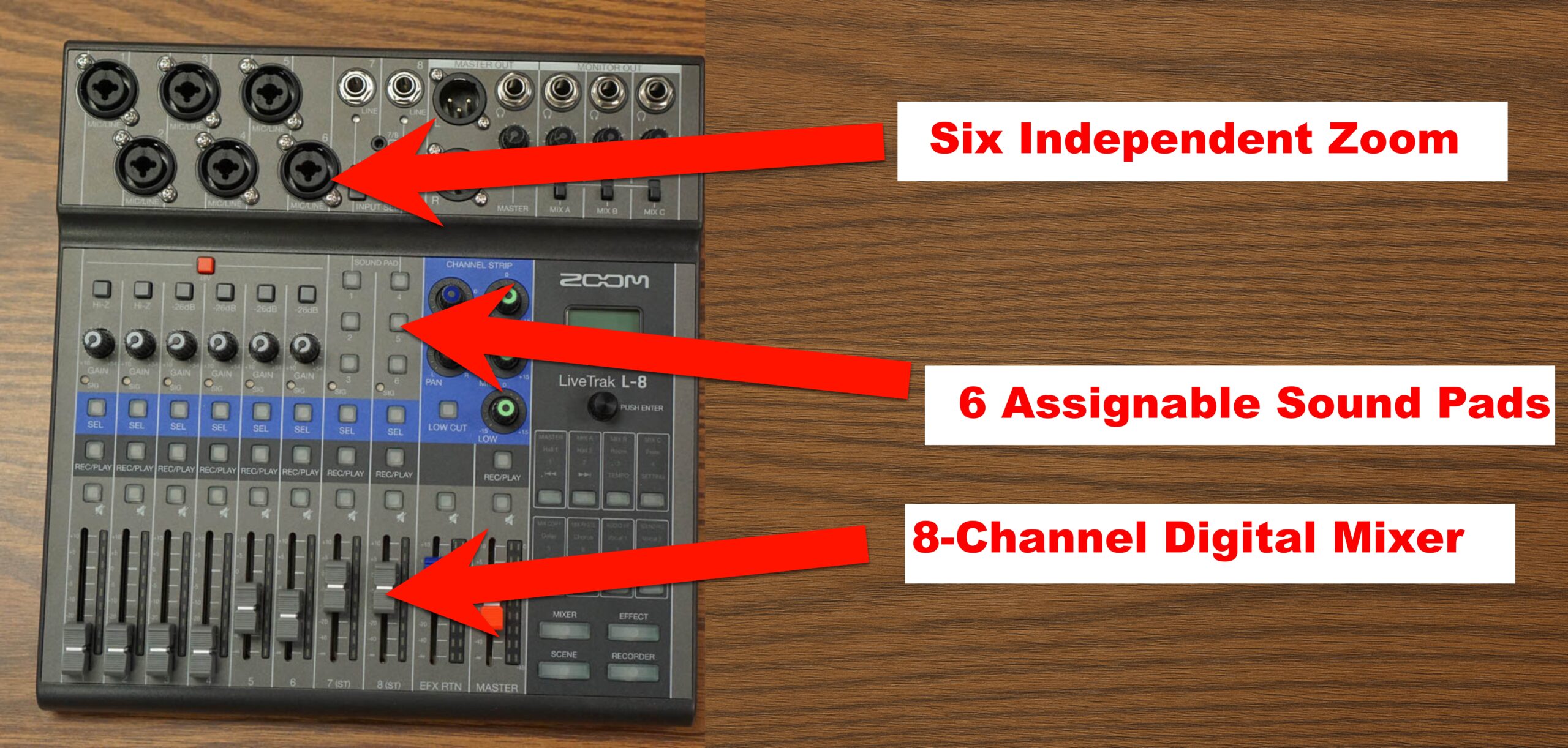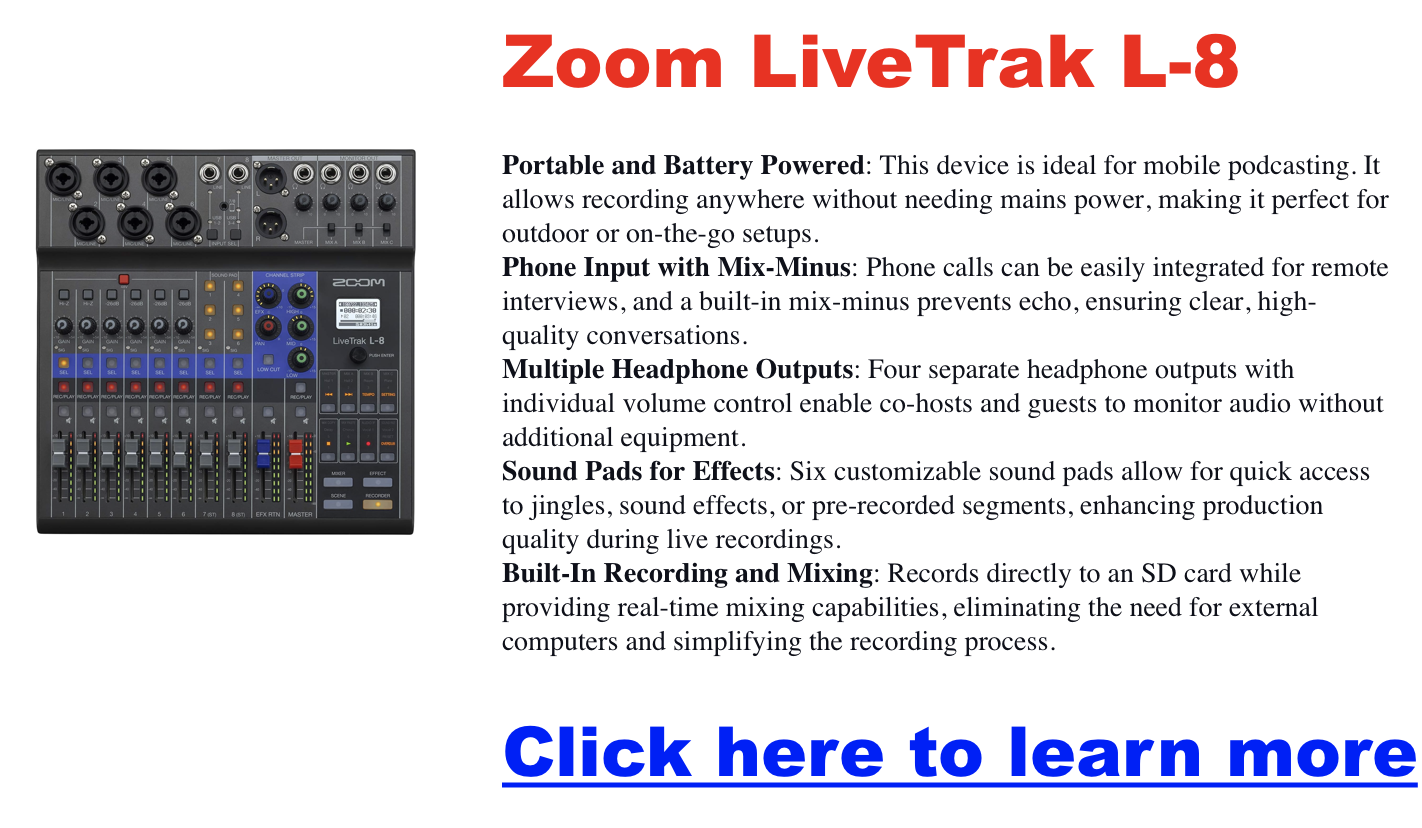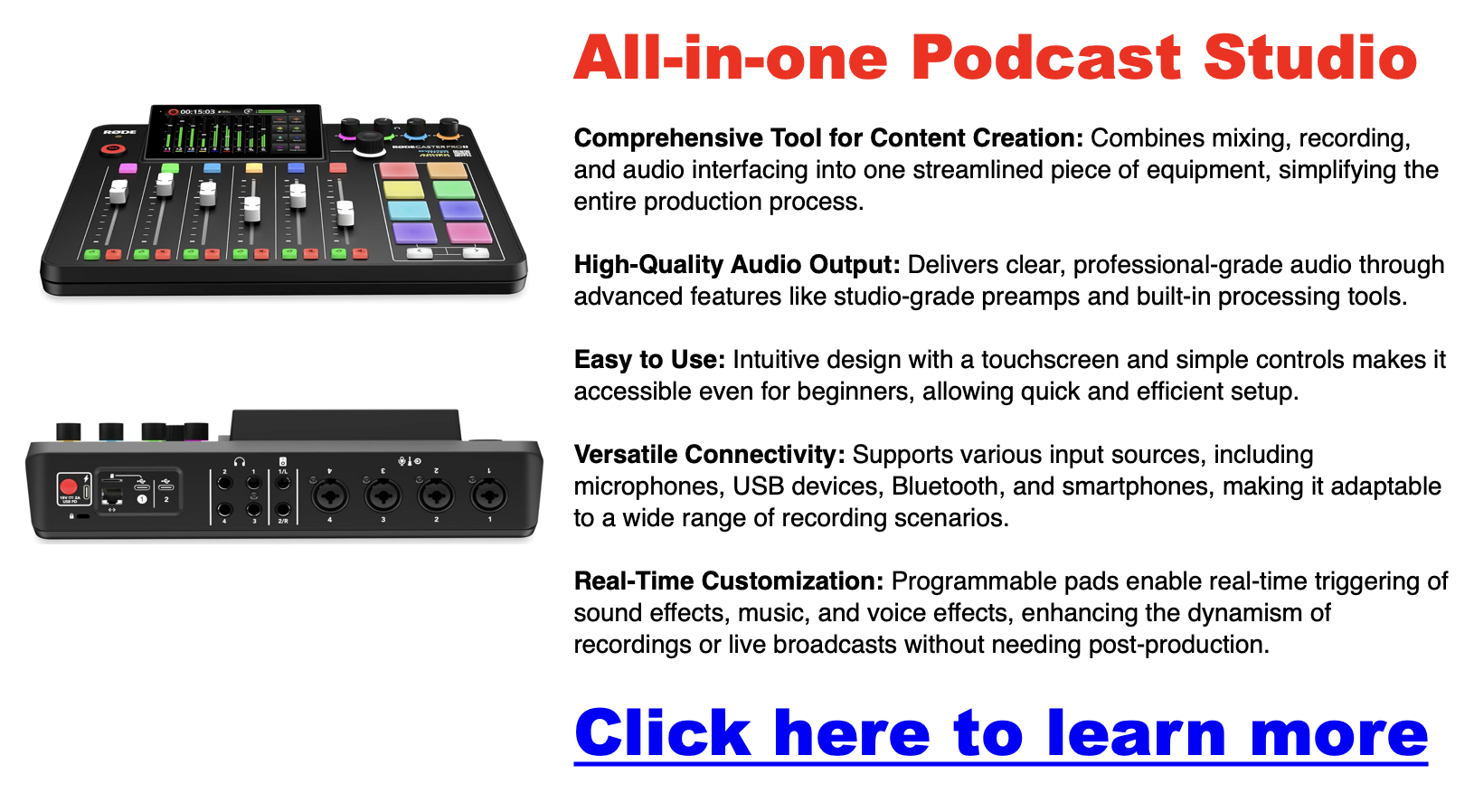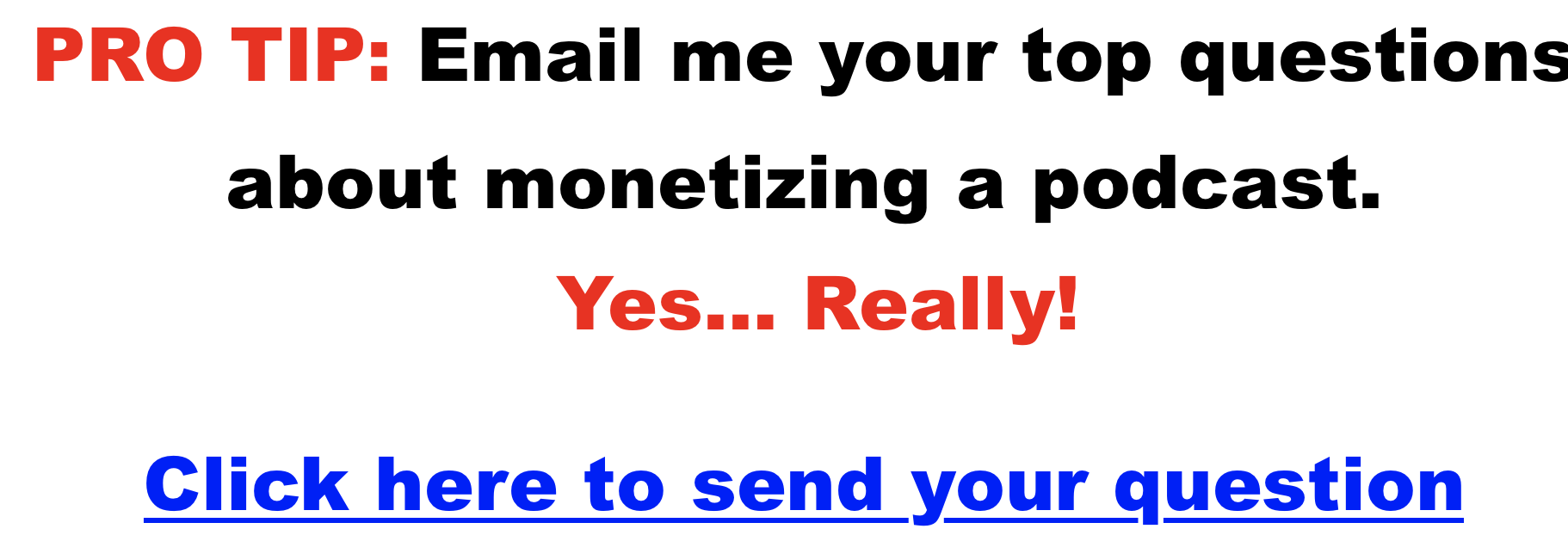Matt
The Best Audio Interfaces That Will Instantly Upgrade Your Podcast
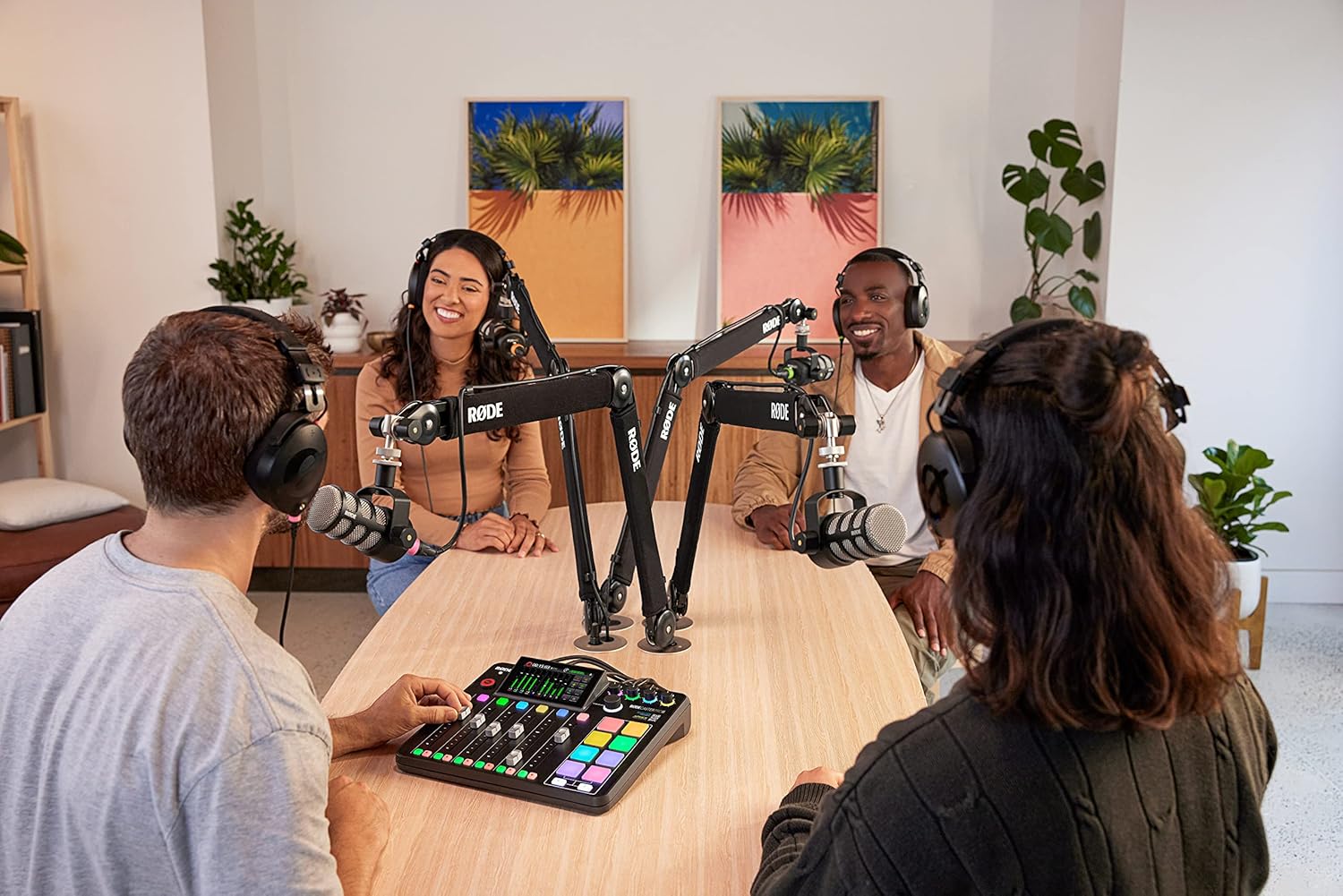 Click Here To Learn More About This Interface
Click Here To Learn More About This Interface
Why Interfaces Matter for Podcasters
Question podcasters ask: “Do I really need an audio interface if I already have a USB mic?”
Expert answer: A dedicated interface is the gateway to professional audio. Unlike a computer’s built-in sound card, it gives you clean microphone preamps, phantom power, accurate conversion, and zero-latency monitoring. If you want your podcast to sound like the shows you admire, this is the piece of gear that takes you from hobbyist to pro.
1. How Many Microphones Do I Really Need?
Question: “How many inputs should I buy?”
- Solo show: 1 input is enough (but 2 gives flexibility).
- Co-hosts/interviews: At least 2 inputs.
- Roundtables/panels: 4–8 inputs.
- Pro tip: Buy one size up, or pick a unit with ADAT expansion to future-proof.
Pros of fewer inputs: cheaper, smaller, easier to use.
Cons: you’ll need to upgrade if your show grows.
Recommendations:
- Solo: Focusrite Vocaster One (simple, podcast-ready).
- Duo: Scarlett 2i2 (4th Gen) (industry standard starter).
- Panel: Zoom PodTrak P4 (budget) or RØDECaster Pro II (high-end).
2. Do Preamps Really Make a Difference?
Question: “Why spend more on preamps?”
Answer: Preamps boost your mic signal. Better ones give higher clean gain (important for dynamic mics like the Shure SM7B) and less hiss.
- Budget pres: fine with condensers, may struggle with quiet dynamics.
- High-end pres: 70–76 dB of whisper-quiet gain (RØDECaster Pro II, Apollo Twin X, RME).
Pros of stronger preamps: no need for external boosters.
Cons: raises the price of the interface.
Recommendations:
- Budget: Audient EVO 4 (console-grade pres).
- Mid: UA Volt 476P (adds analog warmth/compression).
- High: RØDECaster Pro II (Revolution Preamps with 76 dB gain).
3. Which Features Actually Matter for Podcasters?
Question: “Do I need podcast-specific features?”
Answer: It depends on workflow.
- Podcast-centric features:
- Mix-minus (remote calls without echo)
- Loopback (capture computer/Zoom audio)
- Bluetooth/phone integration
- On-board SD card recording
- Sound pads for jingles/sponsors
- Auto gain & Clip Safe (prevent clipping mistakes)
- Traditional interfaces:
- Better suited for those who also record music/voiceovers.
- Clean sound, flexible routing, fewer built-ins.
Pros of podcast hubs: faster production, less post-work.
Cons: larger, pricier, less flexible for non-podcast use.
Recommendations:
- Podcast hub: RØDECaster Pro II or Zoom PodTrak P4.
- Traditional: Apollo Twin X (studio sound) or MOTU M4 (loopback + low latency).
4. Should I Worry About Latency and Connectivity?
Question: “What’s latency and will I notice it?”
Answer: Latency is the delay between speaking and hearing yourself. Cheap interfaces can feel “laggy.”
- USB-C: standard, reliable for most podcasters.
- Thunderbolt (UA Apollo): ultra-low latency, pricier.
- RME/Clarett+ drivers: praised for stability and ultra-low latency.
Pros of paying for better drivers: smoother live streams, no distracting delay.
Cons: higher cost, sometimes more complex setup.
5. Do I Need a Portable or Studio Setup?
Question: “Should I buy for travel or set up a home studio?”
- Portable/bus-powered: Scarlett 2i2, Audient EVO 4, Zoom PodTrak P4.
- Studio/external power: RØDECaster Pro II, Scarlett 18i20, Clarett+ 8Pre.
Pros of portable: lightweight, simple cabling.
Cons: limited inputs/features.
Pros of studio rigs: more inputs, built-in routing, reliable power.
Cons: bulkier, less travel-friendly.
6. Budget Breakdown: What to Expect at Each Tier
Budget (<$150)
- Pros: Affordable, simple, plug-and-play.
- Cons: Limited I/O, plastic builds, weaker preamps.
- Examples: M-Audio M-Track Duo, Behringer UMC22, Audient iD4 MkII.
Mid-Tier ($150–400)
- Pros: Stronger preamps, stable drivers, podcast features (loopback, phone input).
- Cons: More complexity, still limited to 2–4 mics unless expandable.
- Examples: Scarlett 2i2 (4th Gen), Vocaster Two, UA Volt 476P, MOTU M6.
High-End ($500+)
- Pros: Broadcast-quality preamps, ultra-low latency, DSP processing, expandable.
- Cons: Expensive, overkill for casual podcasters.
- Examples: RØDECaster Pro II, Apollo Twin X, RME Babyface Pro FS, Focusrite Clarett+ 8Pre.
7. Quick Scenario-Based Picks
- Solo creator: Scarlett 2i2 (4th Gen) or Vocaster One.
- Two hosts: Vocaster Two (auto-gain, Bluetooth).
- Mobile panel (4 mics): Zoom PodTrak P4.
- Studio panel (4 mics): UA Volt 476P or RØDECaster Pro II.
- Large panels (5–8 mics): Behringer UMC1820 (budget) or Scarlett 18i20/Clarett+ 8Pre (mid/high).
- Pro studio sound: Apollo Twin X or RME Babyface Pro FS.
8. Comparison Table: Top Picks by Tier and Mic Count
| Mic Inputs | Budget Pick (<$150) | Mid-Tier Pick ($150–400) | High-End Pick ($500+) |
|---|---|---|---|
| 1–2 Mics | Audient iD4 MkII – Great entry-level preamps, solid build, simple setup. | Focusrite Vocaster Two – Podcast-specific features (auto gain, Bluetooth, loopback). | UA Apollo Twin X – Pro converters, Unison preamps, real-time DSP. |
| 3–4 Mics | Zoom PodTrak P4 – 4 XLR inputs, sound pads, mix-minus, SD recording. | UA Volt 476P – 4 pres, analog warmth & compression built-in. | RØDECaster Pro II – All-in-one studio hub with 4 Revolution preamps, APHEX DSP, dual USB-C. |
| 5+ Mics | Behringer UMC1820 – Cheapest path to 8 XLR inputs; solid value. | Focusrite Scarlett 18i20 – 8 pres, loopback, ADAT expansion for 16 mics. | Focusrite Clarett+ 8Pre or RME Fireface UFX II – Premium preamps, expandable, rock-solid drivers. |
9. Beyond the Interface
- Microphones: Dynamics (SM7B, PodMic) for untreated rooms; condensers (Rode NT1) for treated spaces.
- Headphones: Closed-back to avoid bleed. (ATH-M20x → budget; DT770 → mid; Rode NTH-100 → pro).
- Accessories: Pop filters, mic arms, headphone amps for multiple listeners.
Final Verdict
Expert advice: Buy for the show you have plus one step ahead. Don’t overspend on features you’ll never use, but don’t limit your growth with too few inputs. For podcasters, the right interface is less about “best specs” and more about best workflow fit.
Podcast Microphone Setup: How to Setup a Mic & Record High Quality Audio
Podcasting has become a powerful tool for communication, entertainment, and education. However, a crucial factor that often separates amateur podcasts from professional ones is audio quality. A good microphone setup can dramatically enhance the listening experience for your audience, making your content more engaging and enjoyable. This comprehensive guide will help you achieve professional-level audio, even if you’re just starting your podcasting journey.
Choosing the Right Microphone
The foundation of a good podcast recording lies in the microphone itself. Two main types of microphones exist:
- Condenser Microphones: Highly sensitive, capturing a wide range of frequencies and nuances. Ideal for studio settings with controlled environments.
- Dynamic Microphones: Less sensitive, better at handling loud sounds and background noise. Suited for live recordings or less-than-ideal recording spaces.
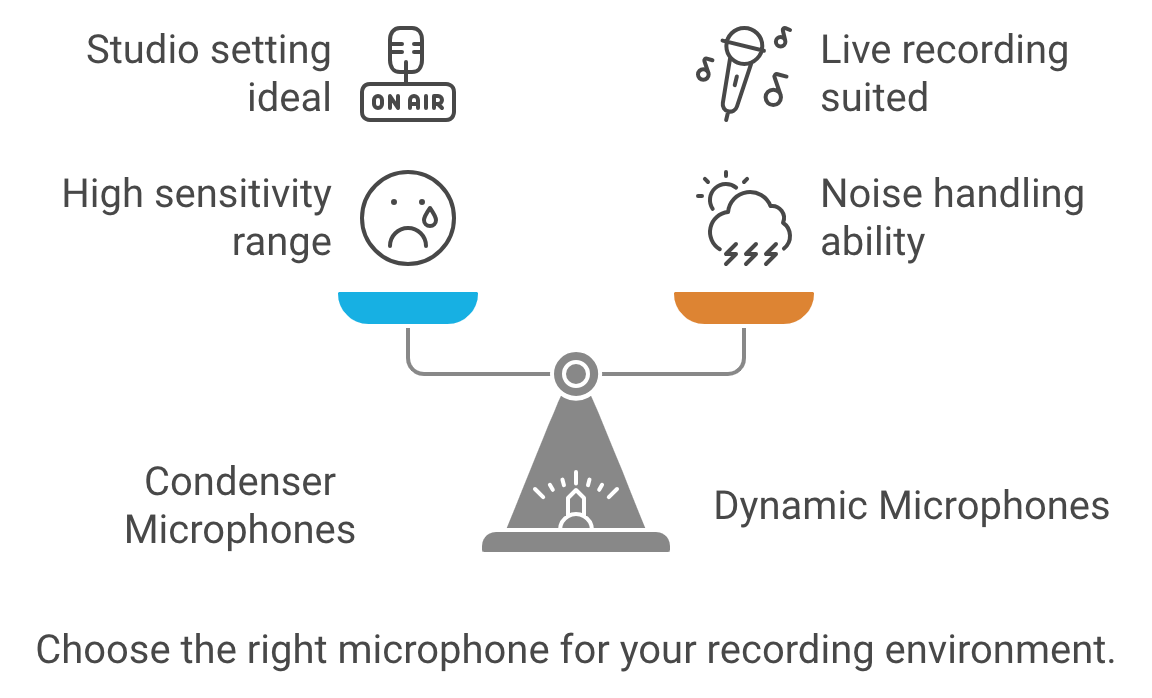
Condenser Microphones
- Sensitivity: Condenser mics are more sensitive and capture a wider range of frequencies and detail, making them ideal for studio environments where sound control is strong.
- Audio Quality: They provide crisp, clear, and detailed sound, making voices sound rich and natural.
- Best For: Quiet, treated rooms without much background noise. If you’re in a professional or home studio, a condenser mic may be an excellent choice.
- Power: Condenser microphones require phantom power (48V) to operate.
- Example: Audio-Technica AT2020, Blue Yeti.
Dynamic Microphones
- Durability: Dynamic mics are rugged and can handle higher sound pressure levels, suitable for live environments.
- Noise Rejection: They are less sensitive to background noise, ideal for less controlled environments like home studios, shared spaces, or noisy areas.
- Audio Quality: While they might not capture the same level of detail as condenser mics, they offer a warm and natural tone, which is more forgiving in untreated rooms.
- Best For Rooms with background noise or for those who need a plug-and-play option without a lot of setup.
- Power: No external power is required.
- Example: Shure SM7B, Electro-Voice RE20.
If you’re unsure where to start, USB microphones offer a plug-and-play solution, perfect for beginners or those with limited setups. As you gain experience, consider upgrading to an XLR microphone for greater control and flexibility.
Best Podcast Microphone Setups
| Microphone | Type | Connectivity | Key Features |
|---|---|---|---|
| Samson Q2U | Dynamic | USB/XLR | Versatile, perfect for beginners, good sound quality, future upgrade flexibility. |
| Audio-Technica ATR2100x-USB | Dynamic | USB/XLR | Similar to Samson Q2U, adaptable to various recording setups. |
| Blue Yeti | Condenser | USB | Multiple polar patterns, versatile for solo or group recordings, easy to use. |
| Rode NT-USB Mini | Condenser | USB | Compact, clear audio quality, minimalist setup. |
| Shure SM7B | Dynamic | XLR | Professional-grade, rich sound quality, commonly used in studios. |
| Rode PodMic | Dynamic | XLR | Broadcast-quality, internal pop filter, durable metal build. |
| Shure MV7X | Dynamic | XLR | Voice Isolation Technology, optimized for spoken word, affordable alternative to SM7B. |
| Dynamic Microphone Kit | Dynamic | USB/XLR | Includes boom arm, gain knob, and mute function for a full setup. |
Creating an Optimal Recording Environment
Your recording space significantly impacts your audio quality. Focus on minimizing background noise and echo:
- Find a Quiet Space: Choose a room away from traffic, appliances, and other noise sources.
- Create a Makeshift Booth: If a quiet room isn’t available, use blankets, pillows, or acoustic panels to dampen sound reflections.
- Use a Pop Filter: This inexpensive tool helps reduce plosive sounds (“p” and “b” sounds) that can cause audio clipping.
Benefits of Using a Pop Filter
Using a pop filter is highly recommended for both condenser and dynamic microphones during podcasting. Here’s why:
- Reduces Plosives: Plosive sounds (like “P,” “B,” or “T”) can cause bursts of air that hit the microphone and create unwanted “popping” sounds. A pop filter helps diffuse this air before it hits the mic.
- Protects the Microphone: The filter also prevents saliva or moisture from reaching the microphone, which can damage sensitive components over time, especially for condenser mics.
- Improves Sound Quality: By reducing harsh sounds, a pop filter contributes to cleaner and more professional audio.
- Helps with Consistent Volume: It encourages you to maintain a consistent distance from the microphone, helping to avoid accidental loudness spikes when speaking too closely.
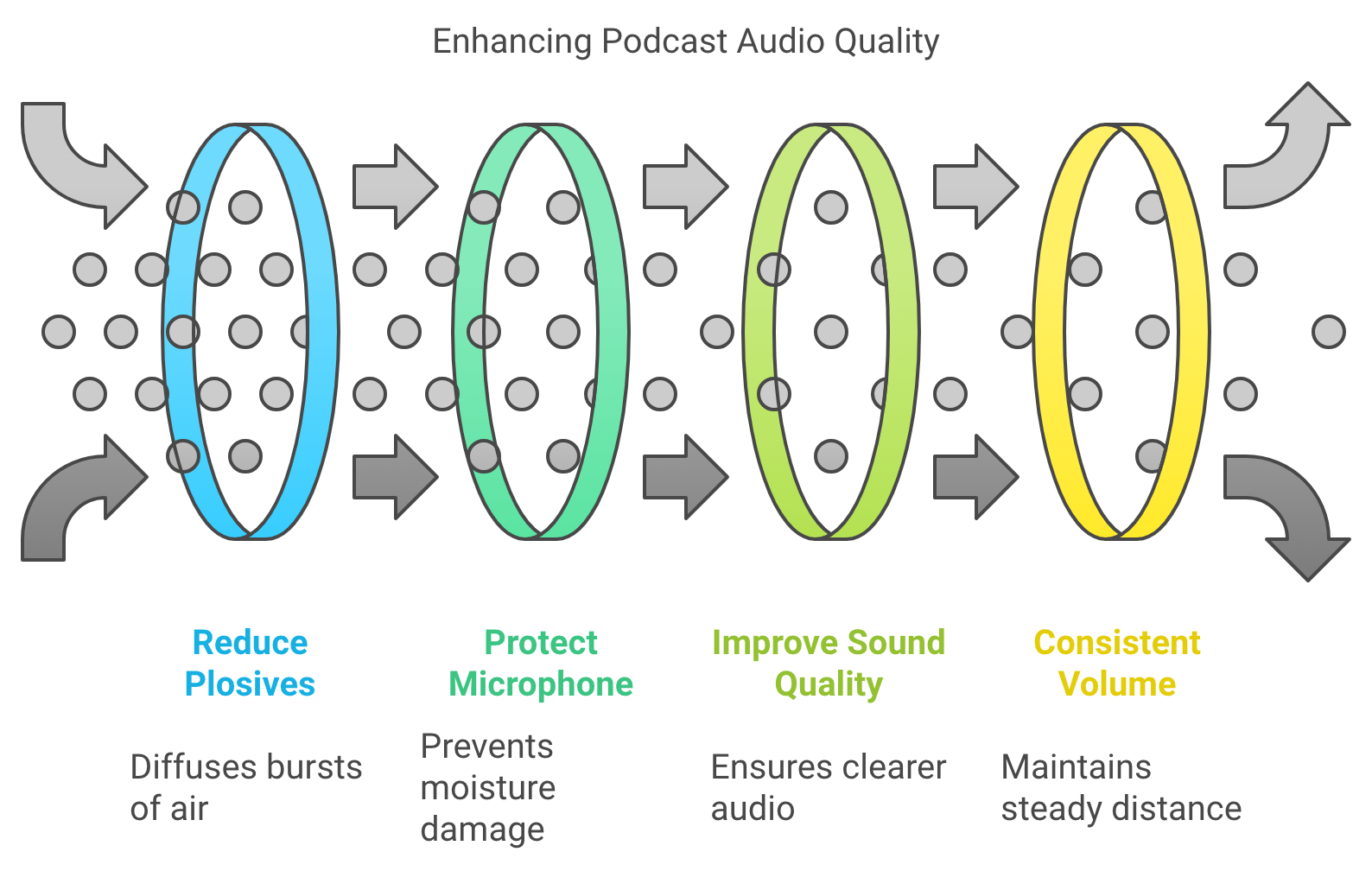
Placement Tips:
- Position the pop filter about 2–3 inches from the microphone.
- Place your mouth 4–6 inches behind the pop filter to get the best sound balance and prevent distortion from speaking too close to the mic.
A pop filter is an inexpensive but valuable tool for achieving professional-sounding audio, regardless of which type of microphone you’re using for podcasting.
Setting Up Your Microphone
Microphone placement plays a critical role in how your voice sounds.
- Position Correctly: For solo recordings, place the microphone 6-12 inches away from your mouth, slightly off-center to avoid breathing directly into it.
- Use a Stand or Boom Arm: This helps maintain consistent microphone placement and frees up your hands.
- Consider a Shock Mount: These reduce vibrations from handling or bumps, keeping your audio clean.
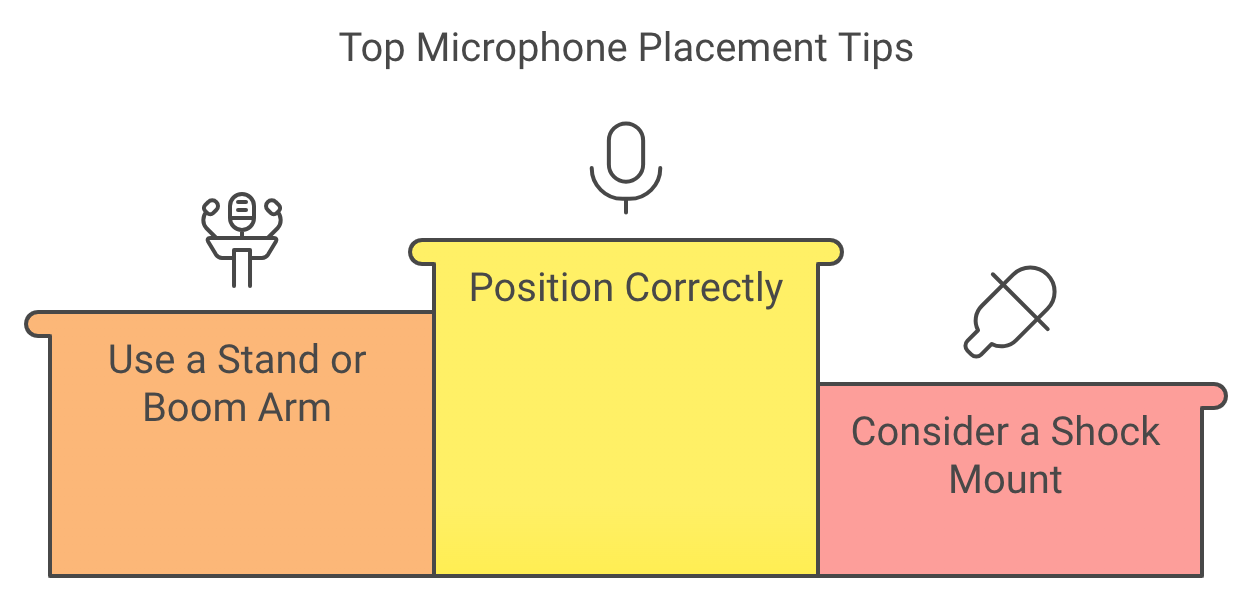
Connecting Your Microphone
Connecting your microphone depends on its type:
- USB Microphones: Simply plug into your computer’s USB port.
- XLR Microphones: Require an audio interface to connect to a computer. They provide better sound quality and more control over recording levels.
- Use Quality Cables: Invest in good cables to ensure a clean signal transmission.
- Monitor with Headphones: Headphones allow you to hear exactly what your microphone is capturing, helping you identify any issues in real-time.
Recording and Editing Your Podcast
Several user-friendly recording software options exist, including Audacity (free), GarageBand (Mac), and Adobe Audition. Once you’ve recorded your audio:
- Edit for Clarity: Remove any unwanted noise, mistakes, or long pauses.
- Adjust Levels: Ensure your audio is balanced and at an appropriate volume.
2-Person Podcasting Setup
Click here for my favorite 2 person podcasting kit
Recording a podcast with two people is straightforward and allows for conversational flow without overwhelming technical requirements. Here’s a guide to setting up a two-person podcast with essential equipment and techniques to create a professional-quality recording.
Equipment Essentials
- Microphones:
- XLR Microphones: Consider XLR microphones like the Samson Q2U or Behringer XM8500 for high-quality audio. These microphones allow you to record each speaker on a separate track, crucial for easy editing and better sound quality.
- USB Microphones: If simplicity and portability are priorities, USB mics like the Blue Yeti are great for beginners. However, they may lack the control and audio fidelity of XLR mics when recording in shared spaces.
- Recommended Kits: All-in-one kits like the Hayner-Seek Bundle and Movo PodKit2AH include microphones, headphones, and audio interfaces, providing an easy setup for two-person podcasting.
- Audio Interface:
- Dual-Input Interface: An audio interface with two XLR inputs, such as the Focusrite Scarlett 2i2, allows you to connect two microphones to your computer while maintaining clear audio quality for each speaker.
- Headphones:
- Closed-Back Headphones: Both speakers should use closed-back headphones to monitor audio without feedback. Options like the Audio-Technica ATH-M20X are budget-friendly and effective for real-time monitoring.
- Recording Software:
- Multi-Track Recording Software: Free software like Audacity or paid options like Adobe Audition provide robust tools for multi-track recording, making editing easier by allowing separate tracks for each speaker.
Recording Space
- Quiet Room: Select a quiet room with minimal background noise to ensure clear audio. Using blankets, foam panels, or other acoustic treatments, especially in smaller spaces, helps reduce echo and improve sound quality.
Recording Techniques
- Microphone Placement:
- Position each microphone about 6–12 inches away from the speaker, slightly off-center to avoid direct breath sounds hitting the mic, which reduces plosives and improves audio clarity.
- Separate Audio Tracks:
- Record each speaker on their own track to simplify editing. Separate tracks allow you to control each speaker’s volume, cut out background noise, and make individual adjustments.
Conversation Management
- Encourage Pauses:
- Remind participants to pause briefly before speaking. This prevents overlap and makes editing smoother.
- Remote Recording:
- Platforms like Podbean, Podcastle, Zoom, or Riverside.fm offer high-quality remote recording options if recording remotely. These platforms support separate tracks for each participant, allowing for better control during post-production.
4-Person Podcasting Setup
Click here for my favorite 4 person podcasting kit
Recording a podcast with four people requires specific equipment and careful planning to capture each voice clearly and avoid crowding the audio.
Equipment Essentials
- Microphones:
- Individual Microphones for Each Speaker: Each participant should have their own microphone to capture clear, isolated audio for each voice.
- XLR Microphones: For professional sound quality, consider XLR microphones like the Shure SM58 or Audio-Technica AT2020, which provide superior sound and individual track recording.
- Recommended Kits: Kits like the Zoom PodTrak P4 provide an integrated solution with multiple inputs, ideal for four-person setups.
- Audio Interface:
- Four-Input Audio Interface: An interface like the Focusrite Scarlett 18i8 or Zoom PodTrak P4 is essential for connecting multiple microphones, each with its own input. This ensures that each microphone records on a separate track, simplifying editing.
- Headphones:
- Closed-Back Headphones for Each Speaker: Every participant should wear headphones to monitor their own audio and the group’s, preventing audio bleed and background noise.
- Recording Software:
- Multi-Track Recording Software: Use software like Audacity (free) or Adobe Audition (paid), which supports multiple audio tracks, making editing each person’s audio easier.
- Mixer (Optional):
- Real-Time Audio Control: A mixer, such as the Rode RODECaster Pro, can help adjust each speaker’s audio levels in real-time, useful for live shows or those looking for more advanced sound management.
Recording Space
- Spacious Room with Acoustic Treatment: Choose a space large enough to comfortably accommodate four people. Use foam panels, curtains, or carpets to reduce echo and improve sound quality, creating a balanced acoustic environment for all voices.
Recording Techniques
- Visual Contact:
- Arrange seating so that all participants can maintain eye contact. This improves the natural flow of conversation and enhances non-verbal communication.
- Separate Audio Tracks:
- Record each speaker on an individual track to simplify editing. Separate tracks make it easier to balance sound, reduce background noise, and control each voice’s volume.
- Noise Reduction:
- Use directional (cardioid) microphones to reduce background noise. This ensures that each mic focuses on the speaker’s voice and minimizes ambient sound, creating a cleaner audio result.
Conversation Management
- Appoint a Moderator:
- Designate one person to lead the discussion and guide conversation flow. This ensures that everyone has a chance to speak and helps manage pacing.
- Encourage Pauses:
- To avoid overlapping dialogue, encourage participants to pause briefly before responding.
- Use Names:
- When addressing someone specifically, use their name. This helps listeners follow the conversation and understand who is speaking.
- Limit Side Conversations:
- Keep the focus on group discussion rather than splitting into smaller side conversations, which can be distracting and hard to follow.
Remote Recording Options
If all participants cannot be in the same location:
- Remote Platforms: For remote recording, use platforms like Podbean, Podcastle, Riverside.fm, Zoom, or Zencastr. These platforms support high-quality, multi-track recording, allowing each participant’s audio to be recorded separately for easy editing.
- Stable Connection and Equipment: Each participant should have a reliable internet connection and their own microphone and headphones to maintain consistent audio quality across all speakers.
How Much Does It Cost To Start a Podcast?
Have you ever dreamed of sharing your passion, expertise, or unique perspective with the world through a podcast but hesitated, wondering if it’s financially out of reach? The good news is that launching your podcasting journey is more accessible than you might think! The cost can range dramatically, but every budget has an option.
Starting a Podcast on a Shoestring Budget
Believe it or not, you can embark on your podcasting adventure for under $200. This approach is ideal for hobbyists, those just starting out, or anyone who wants to test the waters without a significant financial investment.
Essential Equipment:
- Cell Phone: Your phone is a powerful device in and of itself. If you have zero budget, but have a phone, get a voice recorder app and use that to upload to a platform like YouTube.
- Microphone: A decent USB microphone can be found for $50-$100. Options like the Blue Yeti Nano or Samson Q2U are popular choices.
- Headphones: Any pair of headphones you already own can work, but if you need to buy new ones, look for a budget-friendly option around $20-$30.
- Computer/Smartphone: You likely already have one of these. Your existing device is sufficient for recording and editing.
- Recording & Editing Software: Free options like Audacity or GarageBand offer basic functionality.
- Hosting: Several free hosting platforms exist, such as Anchor or Buzzsprout’s free plan, although they may have limitations on storage or features.
Pros and Cons:
- Pros: Extremely affordable, accessible for anyone
- Cons: Limited audio quality, fewer features, potential storage restrictions
Leveling Up: The Mid-Range Podcast Setup Costs
Consider a mid-range setup if you want to elevate your podcast’s audio quality and gain access to more advanced features. This typically costs between $500 and $1500 and is suitable for podcasters who are serious about their craft and want to deliver a more professional listening experience.
Equipment Upgrades:
- XLR Microphone: Invest in a quality XLR microphone like the Audio-Technica ATR2100x-USB or Rode PodMic.
- Audio Interface: An audio interface connects your XLR microphone to your computer and improves sound quality. Models like the Focusrite Scarlett Solo are popular choices.
- Headphones: Upgrade to comfortable closed-back headphones for better monitoring and isolation.
- Pop Filter & Mic Stand: These accessories can further enhance your audio quality and recording experience.
Software & Hosting:
- Paid Recording/Editing Software: Consider upgrading to software like Adobe Audition or Hindenburg Journalist for more powerful editing and mixing capabilities.
- Paid Hosting: Paid hosting plans offer increased storage, bandwidth, and additional features like advanced analytics.
Pros and Cons:
- Pros: Significantly improved audio quality, more features, greater flexibility
- Cons: Higher initial investment
Costs Associated with High-Quality Podcast Production
A high-end setup is the way to go for podcasters aiming for the highest level of audio quality and a full suite of professional features. This setup can cost $2000 or more and is ideal for established podcasters, businesses, or anyone seeking a truly polished and broadcast-ready sound.
Premium Equipment:
- Studio-Quality Microphones: Consider high-end microphones like the Shure SM7B or Electro-Voice RE20.
- Professional Audio Interfaces: Upgrade to a multi-channel audio interface like the Universal Audio Apollo Twin or Focusrite Scarlett 2i2.
- Studio Monitors & Headphones: Invest in studio monitors for accurate audio playback and high-quality headphones for critical listening.
- Soundproofing & Acoustic Treatment: Create a dedicated recording space with soundproofing and acoustic treatment to minimize background noise and improve audio clarity.
Software & Hosting:
- Advanced Software: Utilize professional-grade software for mixing, mastering, and sound design.
- Premium Hosting: Opt for a top-tier hosting service with extensive features, unlimited storage, and robust analytics.
Additional Costs:
- Music Licensing: Secure licenses for any music or sound effects used in your podcast.
- Professional Services: Consider hiring editing, sound engineering, or show production professionals.
Pros and Cons:
- Pros: Exceptional audio quality, full range of features, professional-grade production
- Cons: Significant financial investment, may require additional skills or expertise
Hidden Costs to Consider
When budgeting for your podcast, don’t forget these often-overlooked expenses:
- Website Domain & Hosting: A website can serve as a central hub for your podcast.
- Podcast Artwork/Branding: Invest in professional logo design and cover art.
- Marketing & Promotion: Allocate a budget for advertising, social media promotion, or public relations efforts.
- Travel Expenses: If you plan to conduct in-person interviews or attend events, factor in travel costs.
Tips for Saving Money
- Buy Used Equipment: Consider purchasing used equipment in good condition to save money.
- Take Advantage of Free Trials: Many software and hosting platforms offer free trials, allowing you to test them before committing.
- Learn DIY Skills: Learn how to edit, mix, and master your audio to save on professional services.
- Utilize Free Marketing Strategies: Leverage social media, email marketing, and other free channels to promote your podcast.
Conclusion
Starting a podcast is an achievable goal regardless of your budget. The key is to assess your needs, set realistic expectations, and choose the equipment and services that align with your goals. Remember, the most important thing is to start sharing your voice with the world.
So, what are you waiting for? Take the first step today and embark on your podcasting journey! Let us know in the comments what your podcasting dreams are, or share this post with someone who’s been thinking about starting a podcast.
Zoom Livetrak L-8 for Podcasting
If you’re a podcaster, musician, or live performer looking for a portable, do-it-all mixer and recorder, the Zoom LiveTrak L-8 might be on your shortlist. But is it worth it in 2025? We compiled real user reviews and technical comparisons to help you decide if it’s the right fit for your workflow.
What Is the Zoom LiveTrak L-8?
The L-8 is an 8-channel digital mixer and multitrack recorder tailored for podcasters, musicians, and creators on the move. It delivers pro-level recording quality with minimal setup, powered by batteries or USB, making it ideal for both studio and field use.
Key Specifications
- Channels: 8
- Inputs: 6 x XLR-1/4″ combo, 2 x 1/4″ TS, 1 x 1/8″ TRRS
- Outputs: 2 x XLR main, 4 x 1/4″ TRS headphones
- Recording: 12-track simultaneous, 10-track playback
- Resolution: 24-bit/96kHz
- Dimensions: 10.55″ x 11.1″ x 2.91″
- Weight: 3.4 lbs
Who Should Consider the L-8?
This mixer is a favorite among:
- Podcasters needing mix-minus, multiple headphone outputs, and portability
- Musicians recording jam sessions or live gigs
- Streamers and content creators using iOS devices or OBS setups
Firmware and Software Compatibility
Firmware Updates: Zoom continues to release updates to improve DAW compatibility and recording stability. Always download the latest firmware from Zoom’s official site.
DAW and Streaming Software: Works with GarageBand, Ableton, Pro Tools, and OBS. For iOS use, grab an Apple Lightning to USB Camera Adapter.
iOS Integration: Acts as a 12-in/4-out interface when used with an iPad or iPhone — ideal for mobile setups and podcasting on the go.
Key Features That Stand Out
Portability: Battery-powered, compact, and travel-friendly. Great for remote interviews, church setups, or mobile musicians.
Multitrack Recording: Simultaneously record all inputs to an SD card. Mix on the device or export to your DAW later.
Sound Quality: Includes 6 low-noise mic preamps and onboard effects like reverb and chorus. 3-band EQ + high-pass filter per channel.
User-Friendly Interface: Touch-friendly knobs, intuitive layout, and 6 sound pads for triggering audio clips or stingers during a live show.
Zoom L-8 vs Other Mixers
Zoom L-8 vs. L-12
- Phantom Power: L-8 has group phantom on/off; L-12 allows split (ch. 1–4 and 5–8)
- Size: L-8 is lighter, battery-powered
- Best For: L-8 for mobility, L-12 for bigger setups with varied mics
L-8 vs. Rodecaster Pro
- Processing: Rodecaster has advanced DSP; L-8 offers EQ control instead
- Connectivity: Rodecaster uses USB-C; L-8 uses micro-USB
- Price: L-8 is more budget-friendly
Real Use Case Highlights
Podcasting: Mix-minus works seamlessly for phone interviews. Multiple headphone outs let everyone monitor the session.
Music Recording: Capture high-res multitracks without a laptop. Built-in FX save post-processing time.
Live Sound: Great for performers and public speakers. Easily record live sets or mix stage monitors in real-time.
Pros and Cons
Pros
- Battery-powered, great for remote use
- Multitrack recording and playback
- Solid preamps and onboard effects
- Easy mix-minus for podcasters
Cons
- Group-only phantom power toggle
- Micro-USB instead of USB-C
- Limited onboard effect routing
Frequently Asked Questions
Is it good for beginners? Yes — intuitive interface and sound pads make it beginner-friendly with room to grow.
Can I use it for remote interviews? Absolutely. The built-in mix-minus prevents call feedback — just plug in your phone via TRRS.
Does it run without an outlet? Yes, via 4 AA batteries or USB power bank.
L-8 or L-12? Choose L-8 for mobile use. Go with L-12 for more channels and individual phantom power zones.
Where can I buy it? Amazon, Sweetwater, and B&H all carry the L-8 with occasional discounts and bundles.
Rodecaster Pro: All-in-One Podcast Production Studio
Looking for the best podcast production setup in 2025? The Rode RØDECaster Pro II is a standout solution for creators who want professional-quality sound without the headache of complicated gear. Whether you’re launching your first show or upgrading your studio, this guide breaks down everything you need to know—from features and benefits to expert tips and upgrade advice.
RØDECaster Pro II Overview: What It Does Best
The RØDECaster Pro II is a feature-packed audio production console built for podcasters, streamers, musicians, and content creators. It blends studio-quality preamps, onboard audio processing, customizable SMART pads, and multi-track capabilities—all in one sleek unit.
Key Features:
-
Four high-quality mic inputs with studio-grade preamps
-
SMART Pads to trigger sound effects, voice FX, or MIDI commands
-
APHEX audio processing for pro-level clarity and tone
-
Multi-track recording for post-production flexibility
-
Built-in mixer with faders and multiple input types (USB, Bluetooth, TRRS)
Why Creators Choose the RØDECaster Pro II
High-Quality Audio, No Hassle
With up to 76dB of gain and ultra-low noise, this console eliminates the need for mic boosters—even for gain-hungry mics like the Shure SM7B. It works beautifully with both dynamic and condenser mics.
Beginner-Friendly Design
Despite its power, the RØDECaster Pro II is incredibly easy to use. The large touchscreen interface and intuitive layout mean even first-time users can produce professional-grade sound with minimal setup.
Versatile for All Content Types
This unit isn’t just for podcasts. It’s perfect for livestreams, remote interviews, music production, and video content creation. You can connect smartphones via Bluetooth, plug in USB-C devices, or use traditional XLR mics.
What’s New vs the Original RØDECaster Pro?
The Pro II adds major upgrades:
-
Improved preamps with higher gain and lower noise
-
Dual USB-C ports to connect two devices at once
-
Enhanced Bluetooth for clearer remote interviews
These improvements make it a great step up—especially if you’re managing multi-source audio or want cleaner results without extra gear.
Programmable SMART Pads
The RØDECaster Pro’s SMART pads are more than just sound effect triggers. These eight pads are fully customizable, allowing you to load them with your audio files, music beds, or voice effects. Additionally, you can use these pads for advanced functions like pitch shifting, reverb, and even MIDI commands, giving you full control over your audio environment.
Highlights:
- Customization: Load your audio files and effects.
- Advanced Functions: Includes pitch shifting, reverb, and MIDI commands.
- Dynamic Control: Easily add layers to your content with a single tap.
Advanced Audio Processing
The RØDECaster Pro II is equipped with APHEX audio processing tools, including the Aural Exciter, Big Bottom, and Compellor. These tools are designed to enhance the quality of your audio, whether by adding warmth and depth to voices or compressing dynamic range for a more consistent output. Additionally, the built-in noise gate and compressor help reduce background noise and maintain balanced levels throughout your recording.
Highlights:
- APHEX Processing: Enhances audio clarity and richness.
- Noise Gate and Compressor: Keeps background noise at bay and balances levels.
- Professional Sound: Achieve broadcast-quality audio with ease.
Multi-Track Recording
One of the standout features of the RØDECaster Pro II is its multi-track recording capability. This feature lets you record each input channel separately, which is incredibly useful during post-production. Whether you need to edit out a mistake or apply effects to individual tracks, multi-track recording gives you the flexibility to refine your content to perfection.
Highlights:
- Separate Track Recording: Each input can be recorded individually.
- Post-Production Flexibility: Easier to edit and apply effects.
- DAW Integration: Seamless export to Digital Audio Workstations for further editing.
The RØDECaster Pro II: What’s New?
Key Upgrades
The RØDECaster Pro II takes everything great about the original and enhances it with several key upgrades. The most notable improvements include even better preamps with higher gain and lower noise, dual USB-C interfaces that allow you to connect multiple devices simultaneously, and enhanced Bluetooth connectivity for superior audio quality during remote interviews or call-ins.
Highlights:
- Enhanced Preamps: Higher gain, lower noise.
- Dual USB-C Interfaces: Connect multiple devices simultaneously.
- Improved Bluetooth: Better audio quality for remote connections.
Who Should Upgrade?
If you already own the original RØDECaster Pro, the decision to upgrade will depend on your specific needs. If you frequently work with multiple devices, require even higher audio fidelity, or engage in many remote interviews, the RØDECaster Pro II could be a worthwhile investment.
Considerations:
- Multiple Device Connections: Ideal for complex setups.
- Higher Audio Fidelity: Best for professional-grade projects.
- Remote Interviews: Enhanced Bluetooth for clearer calls.
User Testimonials and Reviews
What Users Love
Many users rave about the RØDECaster Pro’s ease of use, high-quality audio output, and versatility of the SMART pads. It’s often praised for simplifying the production process without compromising on the quality of the final product.
Common Praise:
- Ease of Use: Intuitive and user-friendly.
- Audio Quality: Consistently high across various setups.
- Versatility: Adapts to different content creation needs.
Common Complaints
While the RØDECaster Pro is generally well-received, some users have noted the steep learning curve associated with its more advanced features. The price point can also be a barrier for hobbyists or those new to content creation.
Common Issues:
- Learning Curve: Advanced features may be challenging for beginners.
- Price: Considered expensive by some users, especially beginners.
How to Optimize Your Use of the RØDECaster Pro
Best Practices for Audio Quality
Pay attention to microphone placement and level settings to get the best possible audio from your RØDECaster Pro. Use the built-in noise gate and compressor to maintain clean, balanced audio, and use the APHEX processing to add warmth and depth to your recordings.
Tips:
- Microphone Placement: Keep it consistent and at the right distance.
- Use Audio Processing: Leverage the noise gate and compressor for balanced levels.
- Adjust Levels: Ensure levels are set correctly to avoid distortion or clipping.
Customizing Your Workflow
The RØDECaster Pro is highly customizable, allowing you to tailor its settings to fit your specific needs. Spend some time setting up the SMART pads with your most-used effects and sounds, and adjust the input levels to match your recording environment.
Tips:
- Customize SMART Pads: Load frequently used effects and sounds.
- Adjust Inputs: Set levels that suit your recording space.
- Streamline Workflow: Tailor settings to your production style for efficiency.
Troubleshooting Common Issues
If you encounter issues with the RØDECaster Pro, such as connectivity problems or audio glitches, you can take a few steps. First, ensure that all firmware is up to date. If problems persist, consult the user manual or Rode’s support resources for further guidance.
Tips:
- Update Firmware: Ensure the latest updates are installed.
- Check Connections: Verify that all cables and devices are properly connected.
- Consult Resources: Use Rode’s support and forums for troubleshooting.
FAQs About the RØDECaster Pro
Common Questions
Many users wonder if the RØDECaster Pro can handle multiple simultaneous inputs or what software is compatible with the device. The good news is that the RØDECaster Pro is designed to be highly versatile and works seamlessly with most recording software.
Common FAQs:
- Multiple Inputs: Yes, it can handle up to four simultaneous inputs.
- Software Compatibility: Compatible with most DAWs and recording software.
- Live Streaming: Yes, it’s ideal for live-streaming setups.
Expert Tips
If you’re looking to get the most out of your RØDECaster Pro, here are a few expert tips:
Insider Tips:
- Backup Recordings: Always create a backup of your recordings directly to the microSD card to avoid losing data.
- Firmware Updates: Regularly check for updates to benefit from the latest features and improvements.
Podcast Setup For Two Gear & Thoughts
Podcasts have become an incredibly popular medium for sharing ideas, stories, and entertainment. With the ability to connect with audiences on a personal level, more and more people are venturing into the world of podcasting. If you’re considering starting a podcast with a friend, colleague, or partner, the prospect of a two-person setup might seem daunting. But don’t worry! This guide will walk you through everything you need to know to get your two-person podcast up and running smoothly.
When searching for “podcast setup for two,” you’re likely looking for information on the essential equipment, recording space optimization, and software recommendations specifically tailored for two hosts. We’ll cover all these aspects and more to ensure you have a clear roadmap to podcasting success.
Essential Equipment for a Two-Person Podcast
Microphones
The heart of any podcast setup is the microphone. For two people, you have two main options:
- Individual Microphones: This is the most common setup, providing greater control over individual audio levels and reducing the risk of crosstalk. Consider dynamic microphones for their durability and ability to handle louder voices or condenser microphones for their sensitivity and detailed sound capture. Both USB and XLR microphones are suitable, depending on your audio interface choice. Popular models for two-person setups include the Shure SM58 (dynamic), Audio-Technica AT2020 (condenser), and Blue Yeti (USB condenser).
- Single Microphone: If you’re on a tight budget or have limited space, a single microphone can work. Look for a microphone with a wide pickup pattern, such as a cardioid or omnidirectional pattern, to capture both voices effectively. However, be mindful of potential audio bleed and challenges in balancing individual voices.
Audio Interface/Mixer
An audio interface / mixer acts as the bridge between your microphones and your computer. It converts an analog audio signal from the microphone into digital signal that your computer can understand. For two microphones, you’ll need an audio interface with at least two input channels. Popular options include the Focusrite Scarlett 2i2, PreSonus AudioBox USB 96, and Rode AI-1. To learn more about mixers click here.
Headphones
Headphones are essential for monitoring audio during recording and ensuring a clean, professional sound. Closed-back headphones are ideal for podcasting as they isolate sound and prevent audio bleed into the microphones. Consider options like the Sony MDR-7506, Audio-Technica ATH-M50x, or Beyerdynamic DT 770 Pro.
Additional Accessories
- Pop filters: These reduce plosive sounds (like “p” and “b” sounds) for clearer audio.
- Mic stands or boom arms: Provide stability and flexibility for microphone positioning.
- Shock mounts: Minimize vibrations and handling noise.
- XLR cables: Connect XLR microphones to your audio interface.
Budget-Friendly Options & Podcast Starter Kits
If you’re starting, several affordable podcast starter kits bundle essential equipment, including microphones, headphones, and an audio interface. Popular options include:
- Rode PodMic Dynamic Podcasting Kit: This kit includes two Rode PodMic microphones, two PSA1 boom arms, two XLR cables, and a two-channel USB audio interface, providing everything needed for a basic two-person setup.
- Focusrite Vocaster Two Studio: This all-in-one solution offers a two-channel audio interface, two XLR microphone inputs, two headphone outputs, and a suite of software designed specifically for podcasting.
- Maono AU-A04T USB Condenser Podcast Microphone Kit: This budget-friendly kit includes two condenser microphones, two adjustable boom arms, two pop filters, two shock mounts, and a USB audio interface.
These kits can simplify the process of getting started, ensuring you have compatible equipment while saving money compared to buying each item individually.
Setting Up Your Recording Space
Choosing the Right Location
Use a quiet room with minimal background noise and echo. Smaller rooms with soft furnishings like carpets, curtains, and bookshelves tend to have better acoustics. If you’re recording in a larger space, consider using acoustic panels or blankets to dampen reflections and improve sound quality.
Arranging the Microphones
Position the microphones about 6-12 inches away from each host’s mouth to capture clear audio without excessive plosives or sibilance. Use microphone stands or boom arms to adjust the height and angle for optimal positioning. If using a single microphone, place it equidistant between both hosts and experiment with positioning to achieve a balanced sound.
Connecting the Equipment
- Connect each microphone to an input channel on your audio interface/mixer using XLR cables.
- Connect the headphones to the headphone output on the audio interface/mixer.
- Connect the audio interface/mixer to the computer using a USB cable.
- Configure the audio settings in the recording software to confirm the correct input and output devices.
Recording and Editing Software
Recommended Software
Several excellent recording and editing software options are available, both free and paid. Popular choices include:
- Audacity (Free): A versatile and user-friendly open-source software ideal for beginners.
- GarageBand (Free for Mac users): A powerful and intuitive option with a range of built-in features.
- Adobe Audition (Paid): A professional-grade software offering advanced editing and mixing capabilities.
- Hindenburg Journalist (Paid): Specifically designed for spoken-word audio, offering streamlined editing and mastering tools.
Basic Editing Tips
- Trim: Remove any unwanted sections or mistakes from the recording.
- Noise reduction: Reduce background noise and hum for a cleaner sound.
- Leveling: Balance the audio levels of both hosts for a consistent listening experience.
- Add music and sound effects: Enhance the podcast with intro/outro music and sound effects.
Remote Recording Considerations (Optional)
If you and your co-host are in different locations, remote recording is a viable option.
Tools for Remote Recording
- Zoom: A popular video conferencing platform that also allows for separate audio track recording.
- Riverside.fm: A dedicated platform for remote recording with high-quality audio and video capabilities.
- SquadCast: Another excellent option for remote recording with features like automatic backup and separate track recording.
Tips for Successful Remote Recording
- Stable internet connection: Ensure both hosts have a reliable internet connection to avoid audio dropouts or delays.
- Suitable recording environment: Minimize background noise and distractions in both locations.
- Test audio and video quality: Conduct a test recording before the official session to ensure everything is working correctly.
Additional Tips and Resources
Common Mistakes to Avoid
- Poor audio quality: Invest in decent microphones and ensure a quiet recording environment.
- Inconsistent recording schedule: Maintain a regular release schedule to keep your audience engaged.
- Lack of promotion: Actively promote your podcast on social media and other channels.
Tips for Engaging Content
- Plan your episodes: Outline your topics and talking points beforehand.
- Maintain a natural conversation flow: Avoid scripted dialogues and let the conversation unfold organically.
- Engage with your audience: Encourage feedback and interaction through social media or email.
Conclusion
Setting up a two-person podcast requires careful planning and the right equipment, but it’s an achievable goal with the information and resources available. By following this guide, you’ll be well on your way to creating a successful and engaging podcast with your co-host.
Remember, the most important aspect of podcasting is to have fun and share your passion with the world. So, grab your microphones, fire up your recording software, and let your voices be heard!
How to Start a Podcast on Youtube
In the ever-evolving world of digital content creation, podcasters constantly seek ways to expand their reach and connect with new audiences. One increasingly popular strategy is repurposing podcast content for YouTube, the world’s second-largest search engine and a hub for video consumption. But is this the right move for you? Let’s dive in and explore the potential benefits and challenges of launching a YouTube channel for your podcast.
Is YouTube Right for Your Podcast?
Before you jump headfirst into video production, take a moment to assess whether YouTube aligns with your podcast format and target audience.
- Podcast Format: Some formats naturally lend themselves to video. Interview-style podcasts, where viewers can see the dynamic between host and guest, often thrive on YouTube. Similarly, storytelling or educational podcasts can benefit from visual aids and demonstrations. However, the transition to video may be more challenging if your podcast is highly niche or relies heavily on audio elements like sound effects or music.
- Target Audience: Do your listeners engage with video content? Analyze your audience demographics and preferences. Are they active on YouTube? Do similar podcasts in your niche have successful YouTube channels? Understanding your audience’s viewing habits will help you gauge the potential for growth on the platform.
Weighing the Pros and Cons of Starting a YouTube Channel
Starting a YouTube channel for your podcast offers several exciting possibilities but also comes with its own set of challenges. Let’s weigh the pros and cons.
Pros:
- Expanded Reach: YouTube boasts a massive audience, allowing you to tap into new listeners who might not have discovered your podcast otherwise.
- Monetization Opportunities: YouTube offers various monetization options, including advertising revenue, sponsorships, and merchandise sales, which could potentially create new income streams for your podcast.
- Increased Engagement: YouTube’s comment section and live chat features facilitate real-time interaction with your audience, fostering a stronger sense of community.
- Discoverability: Optimizing your videos for YouTube’s search and recommendation algorithms can boost your visibility and attract organic viewers — MORE ON THIS BELOW! THIS IS HUGE!
Cons:
- Time and Resources: Producing high-quality videos requires time, effort, and often additional equipment and software.
- Technical Skills: Video editing and production may involve a learning curve if you’re new to the medium.
- Audience Fragmentation: Juggling multiple platforms can be demanding, and you risk dividing your audience’s attention.
- Algorithm Dependency: YouTube’s algorithm can be unpredictable, making it challenging to maintain consistent viewership.
YouTube, Google, and the Power of Search
Having a presence that shows on Google & Youtube is a massive advantage because YouTube videos themselves can rank not only in YouTube’s search engine (example: how to videos – how to tie a tie has 60 million views), but YouTube videos also rank in Google (and other search engines too) for a given keyword as well.
Here take a look. This is the search result in YouTube for how to tie a tie… Take a look at the age of the video and the view count. It is a piece of content that has become an asset…. it was created once, and it has been popular for 9-14 years for these top results…. and they earn money on this!

Now lets take a look at the Google result as well…

Check out that thumbnail, the #2 result on YouTube is also the #1 result on Google. Safe to say that it gets a ton of traffic!
I use a keyword tool for Google and a different keyword tool for YouTube — let’s see how popular the search term is, and we’ll get back to why this is important.


I hope you’re following along, because the phrase “how to tie a tie” is searched for over 650 THOUSAND TIMES per month on YouTube itself.
How to Tie a Tie is also searched for over 300,000 times a month on Google itself.
That is close to a million searches a month! And it explains how they got so many views… And you can do this too with your podcast!
Relating It Back to Your Podcast…
I’m trying to show that if you’re strategic with the content you make with your podcast that you could very easily show up in the search results for something somebody is looking for.
That means if you have a podcast episode about something specific like “The Best Strategies for Winning in Dungeon and Dragons” you have a good chance of showing up both in YouTube and Google.
This also means you’ll attract a flood of new listeners to your channel if there is search volume for the topic.
New listeners means more subscribers, more visits to your podcast’s website, more clicks on the offers that get you paid — and a show that is growing exponentially!
If you have a website and a call to action in the podcast and description, you funnel those new listeners to your website and use that to make money (more on that below!).
Key Considerations Before You Launch
If you’re ready to take the plunge, here are some essential factors to consider:
- Content Strategy: Will you simply repurpose existing episodes or create unique video content? Experiment with formats like shorter clips or highlight reels to cater to YouTube’s shorter attention spans. Craft compelling titles and thumbnails to entice viewers to click.
- Technical Setup: Invest in a decent camera, microphone, and video editing software. Plenty of affordable options are available, and numerous free tutorials online can help you master the basics of video editing.
- Promotion and Growth: Cross-promote your YouTube channel on your podcast, website, and social media platforms. Utilize relevant keywords and tags to improve discoverability. Actively engage with your viewers through comments and community features.
Get a Webhost & Leverage Your Show’s Site
Click here to learn how to sign up for web hosting
If you have a website for your podcast, your YouTube channel can become a powerful tool to funnel viewers back to your site. This opens up a world of monetization opportunities beyond YouTube’s built-in features.
-
- Create Engaging Content for Each Episode
- Blog Post: Publish a blog post for each episode, summarizing key points, providing additional context, or offering behind-the-scenes insights.
- Transcript: Include a full or partial transcript of the episode, making your content accessible to a wider audience and improving SEO.
- Resources and Downloads: Provide free downloadable resources related to the episode’s topic, such as worksheets, checklists, or templates.
- Calls to Action: Encourage viewers to visit the website for further information, to join your email list, or to purchase related products or services.
- Create Engaging Content for Each Episode
Creating valuable (aka helpful) and engaging content on your website gives your audience a reason to visit and interact with your brand beyond just listening to your podcast or watching your videos. This fosters a deeper connection, builds trust, and ultimately increases conversion rates for your monetization efforts.
- Monetization Strategies:
- Sell merchandise: Offer branded t-shirts, mugs, or other products related to your podcast.
- Offer premium content: Create exclusive content or early access for paying subscribers on your website.
- Affiliate marketing: Promote products or services relevant to your audience and earn a commission on sales.
- Offer online courses or workshops: Share your expertise and generate income through educational content.
- Secure sponsorships or brand deals: Attract sponsors who want to reach your engaged audience.
- Protect Your Brand: Before launching your channel, ensure your podcast’s name is available as a .com and register it as a trademark to prevent others from using it. This safeguards your brand identity and future growth potential.
Can You Make Money From a Podcast?
Podcasting’s popularity is undeniable, and the potential to monetize these captivating audio creations is growing. If you’re wondering if you can actually make money from a podcast, the answer is a resounding YES! With dedication and strategic planning, podcasting presents numerous income-generating opportunities. Let’s explore some ways you can make money with your podcast.
Direct Monetization Strategies
Click here for a free money-making guide with tons of info
Direct monetization for podcasts primarily revolves around brand partnerships and audience engagement. Partnering with businesses for sponsorships or ad placements within episodes can generate substantial revenue, particularly for podcasts with large and engaged audiences. Additionally, affiliate marketing allows podcasters to earn commissions by promoting relevant products through unique links. Offering premium content or exclusive access via platforms like Patreon for dedicated fans fosters loyalty and creates a sustainable income stream. Finally, accepting donations through platforms or a “tip jar” enables listeners to directly support the show and contribute to its growth.
- Advertising and Sponsorships:
- Partner with brands for pre-, mid-, or post-roll ads within your episodes.
- Consider dedicated sponsored segments or even integrated brand mentions.
- Ad rates depend on audience size, demographics, and niche relevance.
- Successful podcast sponsorships showcase substantial revenue potential.
- Affiliate Marketing:
- Promote relevant products or services with unique affiliate links and earn commissions on sales.
- Choose products that align with your brand and maintain audience trust.
- Popular affiliate networks offer a variety of products to promote.
- Integrate affiliate links in show notes or on your website.
- Premium or Exclusive Content:
- Offer bonus episodes, behind-the-scenes access, or early releases to paying subscribers.
- Use platforms like Patreon for managing memberships and gated content.
- Consider tiered membership levels with varying perks and pricing.
- Donations and Listener Support:
- Invite your audience to contribute financially through donations.
- Platforms like Patreon, Ko-fi, or simple “tip jars” empower listeners to support you directly.
- Express gratitude and offer incentives for generous contributions.
Indirect Monetization Strategies
Beyond direct monetization, podcasts offer indirect revenue streams through merchandise, live events, and content repurposing. Creating branded merchandise like t-shirts or mugs fosters audience engagement and generates additional income. Hosting live shows or workshops, in-person or virtually, offers another lucrative revenue stream through ticket sales and potential sponsorships. Additionally, repurposing podcast content into ebooks, online courses, or consulting services allows podcasters to monetize their expertise while providing further value to their audience. Expanding reach through platforms like YouTube can also open up additional monetization avenues.
- Merchandise Sales:
- Create and sell branded merchandise like t-shirts, mugs, or stickers.
- Tap into inside jokes or memorable moments to design appealing items.
- Leverage social media to promote your merchandise and boost sales.
- Live Events and Workshops:
- Host live shows, meet-ups, or workshops related to your podcast’s theme.
- Charge for admission or offer premium experiences.
- Leverage online platforms for virtual events to reach a broader audience.
- Partner with sponsors or businesses to enhance profitability.
- Repurposing Content:
- Transform podcast episodes into e-books, guides, online courses, or consulting services.
- Monetize your knowledge and skills while providing additional value to your audience.
- Syndicate episodes or create video content for platforms like YouTube.
The Power of Owning a Podcast Website
A dedicated website is absolutely crucial for podcasters looking to maximize their monetization potential and overall success. It serves as the central hub for your show, providing a user-friendly platform to access episodes, show notes, and other valuable resources. A well-designed website with straightforward navigation, mobile optimization, and visually appealing elements creates a positive user experience, encouraging deeper listener engagement and fostering community.
Furthermore, your website is a powerful monetization amplifier, seamlessly integrating with various revenue-generating strategies. You can showcase potential sponsors, prominently display affiliate links, promote premium content subscriptions, and even host your own merchandise store directly on the site. Strategically placed calls to action and banners guide visitors toward desired outcomes, maximizing conversion rates and driving revenue.
Beyond monetization, a professional website is critical in brand building and audience growth. It reinforces your podcast’s unique identity, establishes credibility, and conveys professionalism.
- Central Hub:
- Provides a user-friendly platform for listeners to access episodes and resources.
- Features clear navigation, mobile optimization, and visually appealing design.
- Monetization Amplifier:
- Integrates with various monetization strategies (sponsorships, affiliate links, premium content, etc.).
- Showcases effective calls to action and strategically placed banners.
- Brand Building & Audience Growth:
- Reinforces brand identity and establishes credibility.
- Optimized for search engines to attract new listeners and boost reach.
Conclusion
Podcasting presents a wealth of opportunities for generating income, both directly and indirectly. The possibilities are vast, from advertising to merchandise and repurposed content. This variety of strategies opens up a world of potential for your podcast.
A well-designed, simple, website is a crucial tool for monetization, brand building, and audience growth. By establishing a central hub and leveraging the diverse strategies outlined in this post, you can unlock the full potential of your podcast and turn your passion into a sustainable business.
So, if you’ve been wondering if you can make money from a podcast, the answer is a resounding YES! Embrace the opportunities, experiment, and watch your podcast thrive creatively and financially. With the right strategies and dedication, your podcast can indeed become a source of income.
Buzzsprout vs Anchor
Choosing the right podcast hosting platform is crucial for any podcaster, whether you’re just starting or looking to take your show to the next level. Two popular options that often come up in discussions are Buzzsprout and Anchor.
Overview of Buzzsprout and Anchor
Buzzsprout:
- Key features: Unlimited storage, advanced statistics, multiple team members, customizable website, and excellent customer support
- Pricing structure: Paid plans start at $12/month with a free plan offering limited features.
- Target audience: Podcasters of all levels, particularly those seeking professional features and growth potential
Anchor:
- Key features include free hosting, built-in recording and editing tools, easy distribution to major podcast directories, and monetization options.
- Pricing structure: Completely free
- Target audience: Beginners and podcasters on a tight budget.
| Feature | Buzzsprout | Anchor (now Spotify for Podcasters) |
|---|---|---|
| Hosting | Cloud-based hosting | Free unlimited hosting with a 250MB file size limit |
| Distribution | Automatic distribution to major platforms | Automatic distribution to major platforms |
| Audio Quality | High-quality with Magic Mastering option | Maintains original audio quality, including 256 kbps |
| Creation Tools | Built-in editing and Magic Mastering | Built-in recording, drag-and-drop editing, Spotify music integration |
| Monetization | Buzzsprout Ads, Dynamic Content | Ads by Anchor program |
| Analytics | IAB certified, advanced analytics | Basic analytics, not IAB certified |
| Website | Free podcast website with SEO optimization | No dedicated website feature |
| Pricing | Free (2 hrs/month for 90 days); Paid plans from $12/month | Completely free |
| Pros | User-friendly, excellent support, advanced features | Free, user-friendly, easy for beginners |
| Cons | Limited upload time, no rollover, limited website customization | Limited advanced features, basic analytics, potential platform lock-in |
| Verdict | Great for beginners and intermediates, but limited for long/frequent episodes | Ideal for beginners or hobbyists, but lacks advanced capabilities |
Feature Comparison
- Hosting & Storage: Buzzsprout offers unlimited storage, whereas Anchor has limits depending on your plan. Buzzsprout also supports various audio file types, while Anchor has more restrictions.
- Distribution: Both platforms make it easy to distribute your podcast to significant directories like Apple Podcasts and Spotify.
- Analytics & Statistics: Buzzsprout provides detailed analytics, including listener demographics and engagement metrics. Anchor’s analytics are more basic.
- Monetization: Anchor offers built-in monetization options like ads and listener support. Buzzsprout allows you to integrate with third-party monetization platforms.
- Ease of Use: Anchor is known for its user-friendly interface, making it ideal for beginners. Buzzsprout’s interface is also intuitive but may have a slight learning curve.
- Additional Features: Buzzsprout offers features like Magic Mastering (audio enhancement) and podcast transcriptions. Anchor has built-in recording and editing tools.
Pros and Cons
Buzzsprout
- Pros: Powerful features, reliable hosting, excellent customer support, and growth potential.
- Cons: Paid plans and limited features on the free plan.
Anchor
- Pros: Free hosting, beginner-friendly, built-in tools for recording and editing.
- Cons: Limited features, less control over monetization, potential limitations as your podcast grows
Choosing the Right Platform
- Consider your budget: Anchor’s free plan is attractive if you’re on a tight budget. But if you can invest in your podcast, Buzzsprout’s paid plans offer more value in the long run.
- Consider your experience level: Anchor is perfect for beginners, while Buzzsprout is suitable for those who want more control and advanced features.
- Consider your goals: Anchor’s built-in options might be appealing if monetization is a priority. If you’re focused on growth and need in-depth analytics, Buzzsprout is the better choice
Conclusion
Both Buzzsprout and Anchor have their strengths and weaknesses. The best platform for you depends on your individual needs and goals. Anchor is a great starting point if you’re a beginner or on a budget. But if you’re serious about podcasting and want to invest in professional tools and features, Buzzsprout is worth considering.
Free Podcast Music Providers
In the dynamic world of podcasting, captivating your audience requires more than just compelling content. Imagine setting the perfect mood, enhancing transitions, and leaving a lasting impression on your listeners – all with the power of music. But finding high-quality, copyright-free music can feel like searching for a hidden gem. Fear not, fellow podcasters, for we’re here to guide you through this musical journey!
Free Podcast Music Providers
| Criteria | Pixabay | YouTube Audio | FMA | Podcast.co | Tunetank |
|---|---|---|---|---|---|
| Track Count | 24,000+ | 1,500+ | 100,000+ | 23 | 192 |
| Attribution Needed | No | Sometimes | Yes | No | Yes |
| Commercial Use | Yes | Varies | Limited | Yes | Yes |
| Genre Diversity | High | Medium | Very High | Low | High |
| Download Formats | MP3 | MP3, WAV | MP3, FLAC | MP3 | MP3 |
| Update Frequency | Daily | Weekly | Monthly | Annual | Monthly |
Key Considerations for Free Podcast Music
Before we embark on our exploration of music providers, let’s lay a solid foundation by understanding the essential factors to consider when selecting free podcast music:
- Licensing and Copyright: The legal landscape of music can be tricky. Pay close attention to the licensing terms of each provider. Some may require attribution, while others might have restrictions on commercial use.
- Variety and Genres: Your podcast is unique, and so should be its soundtrack. Seek out platforms that offer a diverse range of music genres to match the tone, theme, and mood of your podcast.
- Ease of Use and Navigation: Nobody wants to get lost in a maze of music. Choose a platform with a user-friendly interface that allows you to search, browse, and download music effortlessly.
- Quality of Music: Your podcast deserves the best. Prioritize providers that offer high-quality audio recordings to ensure a professional and polished sound.
Closer Look At Free Podcast Music Providers
Now, let’s dive into the heart of the matter and explore some of the most exceptional resources for free podcast music:
Pixabay: A Vast Library of Free Sounds
- Overview: Pixabay is a haven for creators, offering a vast library of free stock content, including an impressive collection of music and sound effects.
- Pros: Extensive collection, user-friendly interface, high-quality audio.
- Cons: The sheer volume of content can be overwhelming at times.
- Notable Features: Advanced search filters, curated playlists, and a clear attribution requirement.
- Genres: From ambient and cinematic to electronic, rock, and pop, Pixabay has something for every podcast.
Free Music Archive: Curated Gems for Discerning Ears
- Overview: FMA is a haven for audiophiles, offering a curated collection of free music hand-picked by passionate audio curators.
- Pros: High-quality music, diverse genres, and transparent licensing information.
- Cons: The collection might be smaller compared to other platforms.
- Notable Features: Creative Commons licensing, curated collections, and genre-specific browsing for easy discovery.
- Genres: Indie, folk, electronic, hip-hop, jazz, and a delightful mix of other genres await your exploration.
Incompetech: Royalty-Free Music with a Personal Touch
- Overview: Incompetech is the brainchild of composer Kevin MacLeod, offering a vast collection of royalty-free music.
- Pros: A large and diverse collection, categorized by mood and genre, with easy navigation.
- Cons: The music might have a distinct style that may not suit all podcasts.
- Notable Features: Simple licensing terms with attribution required.
- Genres: From classical and electronic to rock and world music, Incompetech has you covered.
ccMixter: Unleash Your Creativity with Community-Driven Music
- Overview: ccMixter is a vibrant community music platform where artists share their music under Creative Commons licenses, fostering a culture of remixes and collaborations.
- Pros: Discover unique and creative music, embrace the remix culture, and connect with a supportive community.
- Cons: Finding the perfect track might require some extra digging.
- Notable Features: Creative Commons licensing, a plethora of remixes and collaborations, and a community-driven platform.
- Genres: Experimental, electronic, hip-hop, ambient, and a world of sonic exploration await.
Musopen: A Classical Symphony for Your Podcast
- Overview: Musopen is a haven for classical music enthusiasts, offering a vast collection of free classical music recordings and sheet music.
- Pros: Extensive collection of classical music, high-quality recordings, and a valuable resource for educational purposes.
- Cons: Limited to classical music.
- Notable Features: Public domain recordings, sheet music available, and a wealth of educational resources.
- Genres: Immerse your podcast in the timeless beauty of classical music from various periods and composers.
Mastering the Art of Podcast Music Integration
Now that you’ve discovered a wealth of free music resources let’s explore some tips to integrate music seamlessly into your podcast:
- Choose Music that Reflects Your Brand: Select music that complements the tone, theme, and message of your podcast. Let your soundtrack become an extension of your brand identity.
- Strategic Placement is Key: Use music strategically for intros, outros, transitions, and background ambiance. Create a captivating audio experience that keeps your listeners engaged.
- Attribution and Credit: Always follow the licensing terms and give credit to the talented artists who share their music. It’s a small gesture that goes a long way in supporting the creative community.
- Technical Finesse: Ensure the music levels are balanced with your voice recordings for a harmonious listening experience. Experiment with fades and crossfades to create smooth transitions.
Free podcast music providers offer a world of possibilities to enhance your podcast without straining your budget. Remember to explore different platforms, experiment with various genres, and most importantly, respect copyright and give credit to the artists who share their creations.
